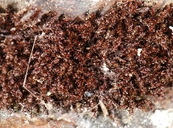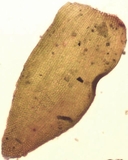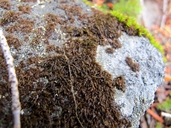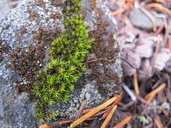- Map Distribution
- Description
- eFlora Distribution
- Illustrations
- Cal Photos images
- Elevation by latitude plot
MAP CONTROLS
1. You can change the display of the base map and layers by clicking on the layer control box in the upper right-hand corner.
2. California county polygons can be turned off and on in the layer control box.
3. Filling of Jepson subdivision polygons can be turned off and on in the layer control box.
Database links
UC Specimens in the University and Jepson Herbaria Public Portal
Specimens of Andreaea alpestris in the Consortium of North American Bryophyte Herbaria portal (CNABH)
Andreaea alpestris (Thedenius) W.P.Schimper in B.S.G. Bryol. Eur. 6: 146. pl. 4.626). 1855. -- Andreaea petrophila var. alpestris Thedenius, Bot. Notiser 5: 79. fig. 45–47. 1849. -- Andreaea rupestris var. alpestris (Thedenius) Sharp in Grout, Moss Fl. N. Amer. 1: 2. 1936
Plants in dense turfs, to 25 mm high, branched only by innovations below the perichaetia, red-brown in younger portions but black in older portions. Stems dark red to black even in young material. Leaves, when dry, appressed in younger portions of the stems, spreading below; when moist, erect spreading. Leaves to 1 mm long, about 2: 1, ovate lanceolate and broadest immediate above the base, only gradually contracted to the obtuse apex, concave below. Median cells arranged in very regular rows, to 8 µm wide, 1–2: 1, isodiametric to elliptic with very irregular lumens due to the strongly trigonous thickenings, incrassate with lumen/wall ratio about 1: 1. Papillae present on the dorsal face of most of the distal 2/3 of leaf, 'arising from over the thick walls instead of over the lumen, solid and unbranched. Marginal cells of leaf base quadrate to short rectangular, 1–3: 1. Upper cells of leaf margin, to 8 µm wide, mostly transversely elongate, to 3: 1. Cells of median leaf base incrassate with sinuose lateral wall, to 5: 1. Costa absent. Margins ascending and entire or minutely crenulate throughout, not at all decurrent. Stem nearly homogeneous, of thick-walled cells without a central strand. Axillary hairs to 40 µm long, 2-celled, not offset, one isodiametric and concolorous, the other elongate and clavate, so thick-walled as to obscure the lumen.
Autoicous, perigonia below the terminal perichaetia. Perichaetial leaves undifferentiated prior to fertilization, becoming much larger and elliptic ovate after fertilization, to 1.5 mm long, closely sheathing most of the pseudopodium. Pseudopodia to 3 mm long, straight. Capsule dark brown except for a pale apex, elliptic, 2–3: 1, to 1.2 mm long before dehiscence, opening by four longitudinal slits. Median exothecial cells to 20 µm wide, 2–4: 1, with thick (lumen: wall ratio 2–3: 1) but with those walls mostly not pitted. Exothecial cells along lines of eventual capsule dehiscence much more elongate and narrow in 1–2 irregular rows. Exothecial cells at capsule apex isodiametric and thin walled, somewhat more narrow than median cells. Stomates absent. Spores to 30 µm, smooth, with trilete mark.
Andreaea alpestris and A. rupestris are our two ecostate members of the genus. While the costa of the costate members can sometimes be seen with a hand-lens, it is perhaps more useful to note the leaf orientation. Four of our costate members of the genus (Andreaea blyttii, A. heinemannii, A. rothii, and A. schofieldiana) all have some degree of subulation of the somewhat falcate leaf apex. The fifth of these costate mosses (Andreaea nivalis) is easily differentiated because it is so much larger and blacker than other members of the genus. Andreaea alpestris and A. rupestris thus stand apart in having broad leaf apices and no falcation. These two ecostate species differ radically when moist in that A. rupestris has some degree of differentiation between the obovate and erect base and the somewhat spreading apex. A. alpestris, in contrast, has elliptic-lanceolate leaves without a spreading tip in the moist plant. We have relatively few collections of A. alpestris from California (Inyo, Del Norte and Siskiyou Counties) but the wide distribution may suggestion inadequate collection.
Vouchers: Del Norte Co.: Whiskey Lake, Six Rivers National Forest, Norris 83366; Inyo Co.: Treasure Lake west of Big Pine, John Muir Wilderness, Inyo National Forest, Norris 46974 & 46975; Siskiyou Co.: trail to Long Gulch Lake southwest of Callahan, Klamath National Forest, Norris 57543 (confirmed by Murray) and McCloud River about 5 miles east of McCloud, Shasta-Trinity National Forest, Norris & Hillyard 103919.
Geographic subdivisions for Andreaea alpestris: CaR, NW, SN. |
Illustration References: Murray 1988.
No illustrations found in database.












